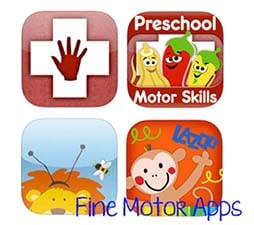Using Apps to Support Fine Motor Development
Most early childhood classrooms are stocked with blocks, crayons, puzzles, and many other tools that support fine motor development. With the iPad becoming ubiquitous across all subject areas in the classroom, does this mean that the manipulatives and toys we once loved no longer have a place in the classroom and will begin to collect dust? One big question continues to pop up: should we replace traditional fine motor development activities and exercises for iPad apps?
The answer is absolutely not! Just as a marathon runner does not simply run to prepare for a marathon, the iPad cannot be the only thing used to support fine motor development. The iPad is simply one tool. However, using the iPad to support fine motor development has its benefits, including:
- At a very basic level, apps are simple video games that require hand-eye coordination and motor control.
- Increased engagement - you can download many different apps that support fine motor development.
- Build visual and spatial awareness at the same time.
- With iPads being omnipresent across education and daily life, students who struggle with small hand movement need additional support in order to become successful with this type of technology in future settings.
Hands-on Fine Motor Activities
 Finger painting
Finger painting- Drawing in sand or shaving cream
- Completing a puzzle
- Playing with snap cubes or LEGOs
- Cutting
- Picking up items with tweezers
- Coloring
- Lacing
- Buttoning clothes
Fine Motor Apps
- Dexteria Jr.($2.99) - Students can choose from three activities that focus on different hand movements. The app contains different levels for each activity which provides for continued engagement.
- Dexteria ($3.99) - Practices similar skills as Dexteria Jr, but meant for a slightly older audience. "Write it" portion works on letter and number formation.
- Uncolor for iPad ($0.99) - This app is great for children that are not ready to use one finger. Perfect to start with children who struggle with small hand movement.
- Bubbles ($0.99) - Children track bubbles and tap to pop.
- Bugs and Buttons ($2.99) - 18 different games that help build fine motor and visual-spatial awareness.
- Lazoo Squiggle (Free) - Children draw squiggles to make cars go, fish swim, and decorate cakes.
- Do as Me ($2.99) - Adults model letter formation or shape formation and the student traces what they wrote. Provides instant feedback.
Here is my advice when considering using apps to support fine motor development:
- Use the app in conjunction with other activities that build similar muscles. For instance, use the app in a fine motor rotation. Rotations can include building with snap cubes, lacing string through a lacing car, and the Bugs and Buttons app.
- Don't just hand the child the iPad and walk away. Interact with the child while they are working. This is a great way to observe where a child might be struggling.
- Do not use the iPad and individual activities for an extended period of time. Try using an app for 5-10 minutes then move onto a different activity that supports the same skill. Similar to the rotation idea, have children practice pinching in the Dexteria Jr.app and then work on similar hand motions by having the child move objects from one bowl to another with tweezers.
- Make sure to develop visual motor as well as fine motor. Find apps that have children track objects with their eyes. The Bubbles app has children tracking the bubbles so they know where to pop.
- Choose apps that build fine motor skills in different ways. In the Dexteria apps, children are pinching, tracing, and squishing.
- Try and find apps with varying levels of difficulty. Children are able to control their learning experience by completing different levels at their own pace. The Dexteria Jr. apps has more complex tracing patterns for children to complete once they feel more comfortable and confident with the task.
- Remember when looking at apps, something may be intended to work on a different academic skill, but it could also build fine motor skills at the same time. Make sure to look across all subject areas in the app store. In the Candy Count (free) app children have to sort different types of candy. This is a great app to support sorting and color recognition, but it is also suitable for building fine motor. Children have to drag the candies into different jars.
Technology is an ever-changing landscape. Make sure to follow our fine motor Pinterest board to see what latest developments and apps are out there!
Looking for more ways to integrate technology and hands-on activities with your students or children? Check out our Blending Hands-on and Digital Learning blog series.
Also, take a look at Stages' cube puzzles; another great manipulative to support fine-motor development.

Lindsey Dunn, Ed.M.
Lindsey Dunn received her BS in Applied Learning and Development from the University of Texas at Austin with a specialization in literacy and teaching English as a second language. After graduating, she began teaching in an inclusive kindergarten setting in Katy Independent School District, a leader in educational technology implementation. During her time as a teacher, Lindsey worked on modifying various educational technologies to meet the range of needs of her younger learners. In 2013 she completed her Ed.M at the Harvard Graduate School of Education with a focus in Technology, Innovation, and Education. Following her time at Harvard, she completed a graduate school fellowship with Education Pioneers, a program geared towards training leaders to transforms the education section. As an Education Pioneer Fellow, Lindsey worked with STEMscopes, a science curriculum publisher, based out of Rice University in Houston Texas. During her summer she facilitated over eighty-five prekindergarten through twelfth grade teachers through the training and development of a new curriculum based on the Next Generation Science Standards. Lindsey has also consulted with large educational publishers and video game designers on effective learning design.





